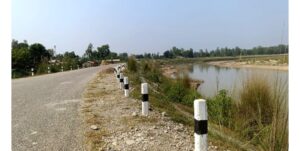
Purna Bahadur shahi
Ph.D. Scholar, VGU Jaipur, Rajsthan, India
Background:
Prithvi Narayan Shah was born 1723 January 7 in Gorkha Darbar. His father’s name is king Narbupal Shah who was the king of Gorkha principality. He enthroned in 1773 April 3. He was very ambitious, farsighted and courageous king. While he enthroned, he decided to expand his territory of principality. Then started to unity the Nepal that was split into variour small principalities. He annexed many principalities to Gorkha (Nepal). After his dearth his successor continued his campaign. His prince Bahadur Shah had given more contributions to unify split Nepal and to comprised many territories of India to Nepal. Teesta in the east, Kankada in the west, and nearby to the confluence of Ganga and Jamuna in the south were annexed by Nepal. India (East India company government) could not bear Nepal spreading out and becoming stronger. So They counter-attacked to Nalapani, Jaithak, and Nakaulanpur and propagated to attack Kathmandu valley. Nepal was weak than India economically. technically, and strategically, so Nepal was compelled to do Sugauli Treaty. Guru Gajaraj Mishra with Chandra Shekhar Upadhyaya for Nepal and parish Bradshow for East India company signed on treaty in 2 December 1815. Treaty was ratified only by the East India company in 4 March 1816.
The treaty of Sugauli concerned to the boundary line of Nepal. The treaty represented a Nepalese peace collaboration to the British and contained the cession of Nepalese western territory to the British East India Company. The provisions of Sugauli Treaty are mentioned bellow.
Article – I
There shall be perpetual peace and friendship between the Honourable East India Company and the King of Nepal.
Article – II
The Rajah of Nipal renounces all claim to the lands which were the subject of discussion between the two States before the war, and acknowledges the right of the Honourable Company to the sovereignty of those lands.
Article – III
The Rajah of Nipal hereby cedes to the Honourable the East India Company in perpetuity all the under-mentioned territories, viz-
First: – The whole of the lowlands between the Rivers Kali and Rapti.
Secondly: – The whole of the low lands (with the exception of Bootwul Khass) lying between the Rapti and the Gunduck.
Third:– The whole of the lowlands between the Gunduck and Coosah, in which the authority of the British Government has been introduced, or is in actual course of introduction.
Fourth:– All the low lands between the Rivers Mitchee and the Teestah.
Fifth:– All the territories within the hills eastward of the River Mitchee including the fort and lands of Nagree and the Pass of Nagarcote leading from Morung into the hills, together with the territory lying between that pass and nagerr. The aforesaid territory shall be evacuated by the Gurkha troops within forty days from this date.
Article – IV
With a view to indemnify the Chiefs and Barahdars of the State of Nipal, whose interests will suffer by the alienation of the lands ceded by the foregoing Article, the British Government agrees to settle pensions to the aggregate amount of two lakhs of rupees per annum on such Chiefs as may be selected by the Rajah of Nipal, and in the proportions which the Rajah may fix. As soon as the selection is made, Sunnuds shall be granted under the seal and signature of the Governor General for the pensions respectively.
Article – V
The Rajah of Nipal renounces for himself, his heirs, and successors, all claim to or connextion with the countries lying to the west of the River Kali and engages never to have any concern with those countries or the inhabitants there of.
Article – VI
The Rajah of Nipal engages never to molest to disturb the Rajah of Sikkim in the possession of his territories; but agrees, if any difference shall arise between the State of Nipal and the Rajah of Sikkim, or the subjects of either, that such differences shall be referred to the arbitration of the British Government by which award the Rajah of Nipal engages to abide.
Article – VII
The Rajah of Nipal hereby engages never to take of retain in his service any British subject, nor the subject of any European or American State, without the consent of the British Government.
Article – VIII
In order to secure and improve the relations of amity and peace hereby established between the two States, it is agreed that accredited Ministers from each shall reside at the Court of the other.
Article – IX
This treaty, consisting of nine Articles, shall be ratified by the Rajah of Nipal within fifteen days from this date, and the ratification shall be delivered to Lieutenant-Colonel Bradshaw, who engages to obtain and deliver the ratification of the Governor-General within twenty days, or sooner, if practicable. Done at Segowlee, on the 2nd day of December 1815. PARIS BRADSHAW, Lt. Col., P.A. Received this treaty from Chunder Seekur Opedeea, Agent on the part of the Rajah Nipal, in the valley of Muckwaunpoor, at half-past two o’clock p.m. on the 4th of March 1816, and delivered to him the Counterpart Treaty on behalf of the British Government.
Amendment to the Sugauli Treaty: The company Government Nepali representatives agreed to amend some of the terms of the Sugauli Treaty. On December 8, 1816, the treaty of Sugauli was amended in the following ways:
1. Nepal will get back the Terai territory from Koshi to Gandaki and from Gandaki to Rapti.
2. If there is a border dispute between the two countries representatives sit down to resolve it, exchanging land with each other if necessary while demarcating the border.
3. The company government did not have to pay Rs. 200,000 annually to Nepal as mentioned in Article 4 of the treaty.
Revised provisions (8 December 1816)
1. to do cession to Nepal from British East India company the while territory from Koshio to Gandaki and Gandaki to Rapti.
2. To solve the disputes concerning border by sitting representatives of both countries and exching the territory as needed.
3. Should not give settle pensions to the aggregaty amount of two lakhs of rupees per year by British East India government to Nepal, as mentioned article No. 4.
It is an unequal treaty because. Any treaty gives both or all parties equitable benefits but here Nepal bears more losses and East India company gets most benefits so it is known as an unequal treaty. There are not any provisions of facilities and concession made for Nepal. The result of the treaty was that Nepal lost almost one third of its territory on the east south and west. India encroached on the Nepalese sovergnity. Due to many poor points of the treaty, experts on international treaty say that Nepal may not be faced to recognize the Sugauli Treaty as a sound treaty. Generally for doing treaty related parties have to be ready willingly. The treaty draft was prepared by Paris Bradshaw on December 2, 1815 and send to Nepal for counter-signature with a 15 day ultimatum and asked to return it. Nepal did not sign within, that period. Then British threatened that they were launching attack on the capital Kathmandu and carried out troop movement to show Nepal that it may serious. At this pitiless moment Nepal had to sign on treaty unwillingly. Article I of the treaty says that the treaty shall be approved by the king of Nepal but there is no record of the treaty being approved by King Girwana Yuddha Bir Bikram Shah. The treaty approved only by Government General Octerlonion behalf of the British Government but not by Nepalese king so. There can be raised question and curiosity about the legality of the treaty. The treaty effects on Nepal’s sovereignty. The treaty says that the disputes between Nepal and Sikkim can be decided by British government. Sikkim and Nepal are not free to solve the disputes. Although now Sikkim is annexed to India. It has not the identification of separate country. It is lost from world map. The sacrifices and hard contributions of Bir Bahadur Shah, Bhakti Thapa, Amar Thapa and diplomacy of Bhimsen Thapa have dishonored due to the Sugauli treaty. The bad consequence of the treaty is that there is seen power struggle in Nepal. It gives the worse result. Article no. 1, 2, 3, 4, 5 are burdened on Nepal and beneficial for British governments.
Most of the experts on International treaty argue that the Sugauli Treaty is not for ever. British had felt that they had done injustice to Nepal by forcing the Sugauli treaty. After the treaty there were territorial disputes immediately. Antu Danda, Illam- 1825, Mechi river 1838, Ramnagar 1840, Tirhut and Sarun were disputed border at that time. As the treaty, boundary demilation is not clear upto now.
Evaluation the Sugauli Treaty the Sugauli Treaty became a very insulting treaty for Nepal. This treaty was a great injustice to Nepalese nationality. It left Nepalese with an incurable wound. The damage Nepal suffered from this treaty was irreparable. Prior to this treaty, the border of Nepal was as far as Teesta in the east and Kangda in the west. Nepal lost one-third of its territory after the treaty.
After the Sugauli Treaty. Nepal had to do the same trend in its foreign policy. Nepal had to keep the Firangis as ambassadors in its capital, which its forefathers tried to keep in mind. Thus, as an ambassador, the British got a chance to see the politics and activities of the country up close. It was easier for them to gather information through their spies. They also sometimes interfered in Nepal’s internal affairs in an unknowing manner. This intervention culminated in Brian Houghton Hudson (1829-1831) the British ambassador. It is said that he also contributed to the downfall of Bhimsen Thapa, the brightest star in the Nepali sky.
Sugauli’s treaty was a unilateral treaty imposed on Nepal. This Nepal had to abide by the treaty. Some of its provisions were highly objectionable. Those clauses completely ignored international values and norms. Article No. 6 of the treaty seeks to resolve the border dispute between Nepal and Sikkim through the mediation of the Company Governmentt, and Article no. 7 states that the king of Nepal may not employ any British, European or American without the permission of the British Government. Some foreign scholars have claimed that after this treaty, Nepal’s sovereignty and integrity were shattered and Nepal’s independent existence ended. But Articles 1 and 8 or the treaty confirm that Nepal’s independent existence was not destroyed by this treaty.
The treaty seeks to keep each other on an equal footing, respecting each other’s independence, integrity and sovereignty, even as the exchange of ambassadors to each other’s countries is written to secure and develop friendly and peaceful relations.
The treaty of Sugauli cannot by judged on the basis of twentieth-century international law. Although some of its provisions seemed harsh, it was never used in view of the friendship between the two countries. In fact, the unpleasant articles of the treaty were framed on the basis of war-mongering and skepticism. But impressed by the friendship and goodwill shown by Nepal after the treaty, the British government did not treat Nepal harshly. After this treaty, there was no interference in the internal affairs of the nation at the governmental level except for the company government occupying some territory of Nepal. The British government, in view of its friendship with Nepal, later returned some places to Nepal. New countries like Kailai, Kanchanpur, Banke and Bardiya, which were returned to Nepal on November 1, 1860 during the time of Rana Prime Minister Jung Bahadur, are examples of this.
There is a question as well as curiosity concerning the legality of Sugali treaty because it was ratified only by British east India company not by Nepal while treaty provision says that it is compulsory to ratify the treaty by both governments. Most of the experts on international treaty argue that it was unequal treaty because most of the provisions in favor of British government generally. It is said that the parties of the treaty are benefited equally. The treaty is not forever. Most of the provisions provisioned on treaty are untimely as well as irrelevant. After being Independence from British colony , there are no treaties, agreements regarding domination of the territory of greater Nepal by the republic of India. The land seized by British colony from Nepal should no longer remain under present India’s dominion. There is no substantive proof of ownership with India to occupy the territory that cuts-off greater Nepal. After the treaty of peace and friendship between Nepal and India signed on July 31, 1950, all previous treaties and agreement are invalid and outdated. The original copy of the treaty is not available right now. It is said that it has been lost. Another side, most of the historical document and maps that are available in the library of congress- is a, British library London, National Library of Beijing-China. It is said that if there is economic and social progress, Nepalese could increase their capacity to think logically and rationally, with the increasement of social awareness in the Nepalese society, it will gradually increase the feeling of love of nation or patriotism one day. Nepal will be able to dishonor the Sugauli treaty of 1816 which was signed under coercion. The treaty makes the unification campaign of Nepal end for over. After the treaty Nepal had been trapped from internal altercation. As a result, Kot parba, Bahadur parp and so on political scam were seen and arised Rana Regims by Jang Bahadur Rana. Nepal had lost one third territory and faced dishonor as well as defamation. Nepalese diplomacy proved loose poor and immature.
References
1. Manandhar, Mangal Siddi, Koirala, Hriday Lal (2001), “Nepal-India Boundary issue; River Kali as international Boundary” Tribhuwan University Journal, 23(1).
2. Shrestha, Buddi Narayan, (2000), ” Boundary of Nepal”, Bhumichitra Co.P. Ltd., Kathmandu.
3. Upadhyaya, Shree Ram Prasad, ” History of Nepal, (2020),” Ratna Pustak, Bandar, Kathmandu.
4. https://en.m.wikipedia.org>wiki
5. https://www.britanica.com>event







